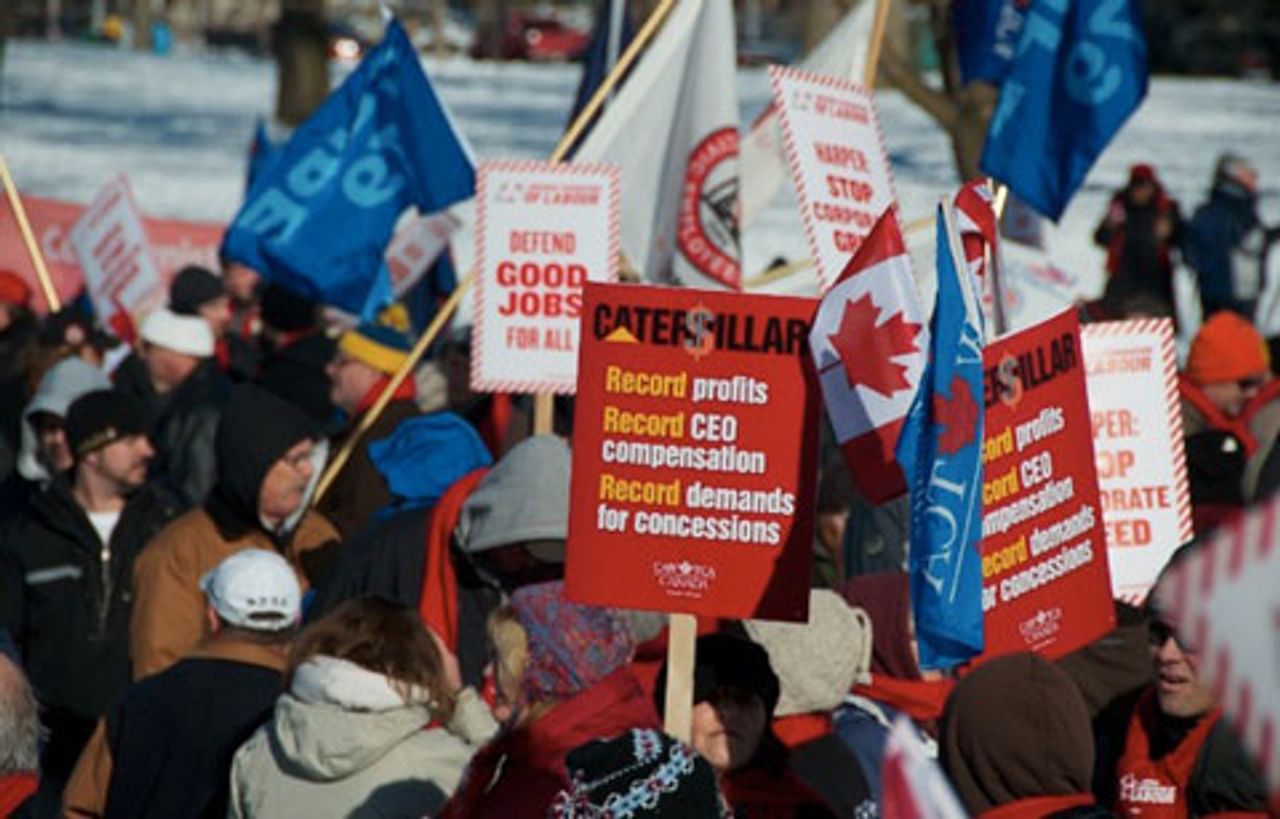 The crowd at the rally in London
The crowd at the rally in LondonSome ten thousand workers and young people from across the province rallied in London, Ontario Saturday to support locked-out train locomotive builders at the Electro-Motive Diesel facility in the city.
The 465 locked-out workers, members of Local 27 of the Canadian Auto Workers (CAW) union, are entering their fourth week on the picket line in a battle against multinational corporate giant Caterpillar Inc. The company is demanding wage cuts of more than 50 percent, the destruction of the workers’ pension plan and other sweeping contract concessions.
 Demonstrators at the rally
Demonstrators at the rallyMany workers at the London event could be forgiven if they experienced a certain sensation of déjà vu. The rally, called by the CAW, the Canadian Labour Congress (CLC) and the Ontario Federation of Labour (OFL), took place almost one year after a similar protest was held in Hamilton, Ontario to support locked-out US Steel workers. At the 2011 gathering, union and New Democratic Party (NDP) leaders pledged that they would stand by the locked-out steel workers to the bitter end. Instead they systematically isolated their struggle and last October the United Steel Workers imposed a concessions-laden contract on them.
At Saturday’s rally in London, workers, outraged by the draconian attack on their living standards launched against them by Caterpillar and tacitly supported by the big business provincial and federal governments, were likewise “treated” to a stream of pseudo-militant bluster and nationalist demagogy. For the union and NDP leaders, such “Days of Action” are an alibi for inaction—a mechanism for suppressing the class struggle and diverting workers into making futile appeals to the very politicians who are implementing the agenda of the corporations.
Saturday’s rally opened with the singing of Canada’s national anthem. Although enthusiastic renditions could be heard emanating from the assemblage of assorted union bureaucrats and politicians on the podium, a very half-hearted effort was offered up by the crowd. One worker called out, “What is this? A hockey game?” Another worker, clearly exasperated by a clutch of NDP supporters waving signs that read “Canadian Jobs First” to the strains of “O Canada”, interrupted the singing to ask, “We have brothers from America here today. How about everyone’s jobs first?”
A series of labour officials and politicians, including London’s Liberal Mayor and the interim leader of the NDP, then proceeded to address the crowd. All spoke against the Harper federal government. But the big business provincial Liberal government of Dalton McGuinty remained off-limits to the speakers, since the CAW has endorsed their candidates for the past four elections.
Nycole Turmel, leader of the NDP until this spring’s national convention, drew groans from a crowd clearly looking for a way forward, when she concluded her speech by assuring the locked-out workers, some of whom soon face mortgage foreclosures, that “we have three years (until the next election) to build a movement against Harper.”
The presence on the stage of Mayor Joe Fontana was particularly provocative. Fontana, an enthusiastic supporter of federal Liberal Finance Minister Paul Martin’s vicious budget cuts of the 1990s and an eventual Minister of Labour, increased his anti-working class notoriety last November when he became the first mayor in the country to mobilize police to evict Occupy protestors.
Echoing calls from other speakers, Fontana demanded that Prime Minister Harper “get his ass down here”. What purpose a visit by one of the most virulent anti-worker prime ministers in Canadian history would serve went unanswered by the podium speakers throughout the day.
A revealing moment occurred when “Anthony”, a spokesperson for the Occupy London movement addressed the gathering and called for civil disobedience and direct action to resist Caterpillar. “We shouldn’t rely,” said Anthony, “on appealing to political institutions that don’t represent us anymore. We should be taking back the factories and our schools”. The speech drew some of the loudest applause of the afternoon with the crowd breaking out into a boisterous chant of “We are the 99 percent”.
This was all too much for CAW Local 27 president Tim Carrie. Taking the microphone, Carrie immediately moved to disassociate the CAW from any militant action against Caterpillar. “We’re not going to be drawn into a position where they can paint us as union thugs,” he exclaimed. “We have taken an approach that we are going to fight this peacefully”.
It was left to CAW national president Ken Lewenza to explain what that actually meant. In one of the shortest speeches of the day, Lewenza called on Caterpillar to return to the bargaining table. He failed to mention that the CAW leadership has already signaled to the company that it is now ready to make significant concessions—concessions over and above those made in the last contract, which allowed Caterpillar/EMD to boost productivity by 20 percent.
The focal point of Lewenza’s speech at Saturday’s rally was to call on Harper to bolster the government’s power under the Investment Canada Act to put requirements on foreign firms purchasing large companies.
The labour bureaucrats’ framing of the struggle at Caterpillar in nationalist terms, as a struggle of “Canadian workers” against a greedy “American” company, has a double-reactionary purpose: to oppose and thwart all attempts to unite workers in Canada and the US in a common struggle; to serve as a cover for their collaboration with big business in imposing concessions and job cuts, in the name of “saving Canadian jobs.”
In opposition to the flaccid and chauvinist perspective offered from the podium, supporters of the World Socialist Web Site broadly circulated a four-page “Caterpillar Worker Newsletter” that explained the need for workers to break organizationally and politically from the pro-capitalist unions and social-democratic NDP, oppose the subordination of workers’ needs to investor profits, and fight to unite workers across North America and around the world in a common struggle against the transnationals. The Newsletter urged workers to seize the leadership of their struggle through the building of rank-and-file committees, independent of and in opposition to the CAW, and to make their non-concessions struggle the spearhead of an industrial and political offensive of the entire working class in defence of job, decent wages and pensions, and public services.
The Newsletter included a Socialist Equality Party (Canada) statement on the way forward for the Ontario Electro-Motive workers, a comment entitled “Some Hard Truths about the CLC-OFL’s ‘Days of Action’”, interviews with workers at the La Grange, Illinois EMD plant, and an article on the 75th anniversary of the Flint sit-down strike, a social explosion that reverberated on both sides of the Canada-US border.
Subscribe to the IWA-RFC Newsletter
Get email updates on workers’ struggles and a global perspective from the International Workers Alliance of Rank-and-File Committees.
